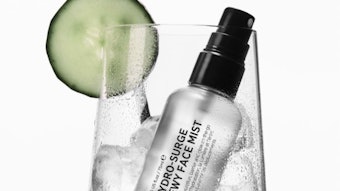- Consumers are looking for multifunction ingredients and curbing spending habits.
- The marketing/benefit message must be more focused and specifics communicated to the consumers.
- The decision to use a particular raw material should be a mix of both function and how it elevates a brand/story image.
- Consumer decisions will be driven more by compelling performance than by mere label claims.
- Consumer expectations for superior packaging for advanced products continue to rise in both mature and developing markets.
The Panel: Allyson Owens, Director of Education, DermaQuest; Frank Massino, CEO, Senetek PLC; Ada Polla, President and CEO, Alchimie Forever; Virginie Lemeunier, Product Manager—Lotion, Rexam Personal Care Division; Ralph J. Manrique, Skin Care Global Marketing Manager, AkzoNobel Surface Chemistry
GCI: Have consumer habits such as spending, product choices, frequency of spend and so on, changed in the last eight months? How have they changed and what have you done to adjust?
Allyson Owens: In the past eight months, accounts have been ordering less. Before they would order larger quantities of the same product, but now those quantities have been cut in half—or even more than half. You can tell they have budgets to work with now and have scaled back on ordering. It seems like they don’t want to be holding too much inventory right now. We are providing our accounts with more marketing materials, samples, point-of-purchase displays, shelf talkers, posters, marketing cards, etc., to help them retail products and increase revenue. These days, people are looking for value as well as results. If a product can fulfill many expectations or functions, then that is a great product. Our Peptide Mobilizer can be used on the eye area and on the face, and is our number one age management product.
Frank Massino: Consumer spending has been on the decline, and we see it even in physician visits across the country. Consumers appear to be trying to get more out of a single tube, looking for better pricing, etc. We have implemented several promotional campaigns attempting to address the consumer concern and plan to implement some bundling prices.
Ada Polla: Consumers are still interested in looking younger and in using products that will make them feel and look better. However, they are more budget-conscious. Spas that carry our line are seeing consumers purchase two instead of three or four products—a moisturizer and an eye contour cream, but not a day and night cream and a mask and eye contour cream. As a result, we are adapting our marketing language to emphasize multiple benefits in a single jar. As consumers are also getting facials less frequently, we are emphasizing the importance of a home skin care regimen to maintain the benefits of in-spa treatments.
GCI: Is it enough to simply make an antiaging claim, or do the messages about performance/target treatment area have to become more narrowly focused and communicated to consumers? There are many antiaging products for specific areas of the face, for example. Does a product’s retail success depend on it performing a very specific function? How does this challenge how you market? Does communicating the details on an expansive line make it more difficult to impart a general brand story toward connecting with consumers?
Allyson Owens: We find that a lot of people believe product claims without any background information or specific information about ingredients. However, there are an increasing number of savvy customers who want to know how a product works and what specific ingredients do. It is important to be specific and give customers as much information about a product and its ingredients. We are very up-front at DermaQuest about the performance ingredients we formulate with and even the percentages of the actives we use. We formulate with the highest recommended percentage.
Frank Massino: Definitely the message must be more focused and specifics communicated to the consumers. It seems that a product success initially relates to the amount of advertising dollars being spent, but I am not sure that most consumers, right now, are looking at the specifics, but actually expect a product to do everything. This, perhaps, is the reason that there are so many new products and line extensions introduced—as consumers become frustrated with the overall results. We need to be better at communicating exactly what a product will do and not overstate or overpromise. The biggest issue today in the antiaging treatment area is that there are no barriers to entry—i.e., no required testing to prove and substantiate the claims. Too many [companies] promise the moon, yet there are no true controlled clinical studies to back up their claims. Much of the testing that is being used to allegedly support a claim is done with focus groups; these are not controlled trials but rather opinions.
Ada Polla: I believe that the efficacy of current skin care marketing messages depends on its truth and accuracy. Above all, consumers are looking for truth and trust in marketing. That is more easily achieved from the brand’s perspective if the claim is narrower—i.e., more specific and less open to interpretation. For example: it will “increase skin firmness after one application” instead of “will have antiaging results.” At the end of the day, the consumer will still spend on products that work; that yield results.
GCI: How do you communicate the benefits of your products to consumers who are becoming both savvier about ingredients/claims and have the choice of so many new and evolving products and ingredients?
Allyson Owens: We provide informational sheets showing our ingredient list, our key performance ingredients and percentages used of these ingredients. We also take before-and-after pictures, which is the real proof.
Frank Massino: All Senetek products that are or will be introduced to the physician and consumer market must be advancements and have differential advantages over the existing treatments available. Every product or SKU undergoes significant controlled clinical trials in humans for both safety and efficacy. For example, in regards to safety, each Senetek product is tested for human chromosome aberration, mutagenicity and dermal irritation ... undergoing every test that is required by the FDA for a prescription product, and our testing is animal-free. Then for safety, extensive cell culture work is done for identifying biological activity and then goes before an IRB at a noted university with a well-known department of dermatology for live controlled clinical trials at the university clinic under the guidance of a board-certified dermatologist. During the clinical trial, blood work is done periodically, silicone profilometry and a sort of facial mapping is done—in addition, concrete, computerized specific measurements such as the amount of moisture being retained or loss through the skin barrier, are taken. Senetek is on the leading edge of testing and we are now just beginning to get this message out through conventional media such as print, as well as focusing on new media such as the Internet. We are actively reporting on the excellent clinical findings that physicians have found with our products.
Ada Polla: We have recently invested more in clinical studies, performed by independent labs and based on quantitative (not qualitative) results. While skin care is about magic, dreams and emotions, consumers will more readily try new products if the claims are backed up by data. Mystery, backed by facts …
GCI: How do you stay abreast on ingredient/technology advances and make decisions about any new ingredients/technologies? What do you first evaluate, an ingredient’s function or how it elevates your brand story/image?
Allyson Owens: We meet regularly with raw material manufacturers, attend trade shows and meetings, as well as read trade publications and trade newsletters. The decision to use a particular raw material definitely is a mix of both function and how it elevates a brand/story image. We wouldn’t use an ingredient that didn’t elevate our brand image, but we also wouldn’t choose to use a raw material that doesn’t work or benefit the product formula.
Frank Massino: Senetek [has the benefit] of working with world-class scientists—having the likes of Brian Clark as chief scientific officer, the scientist who discovered the initiation of the protein codon, did the first crystallization of tRNA, heads up the European/Chinese biotechnology transfer task force, ad infinitum. We have at our disposal thought leaders such as Sir John Walker, 1997 Nobel prize winner in chemistry and an expert on nutrition and aging. Perhaps most significant, we are a selected member of the European Proteomage, a collection of 19 independent laboratories that study the science of aging and have various significant collaborations throughout the world—such as the Institute of Experimental Botany in the Czech Republic, the Polish Academy of Biorganic Sciences, etc. We definitively evaluate the function and benefits of the ingredient first and foremost, following our mission in that we will only introduce proprietary compounds possessing differential advantages.
Ada Polla: We are extremely committed to staying current and informed of new technologies and state-of-the-art ingredients. As such, we invest in conferences and courses, sending our R&D team to these educational opportunities. When new ingredients surface, we will, first and foremost, evaluate their fit with our philosophy. We ask, for example, is the new ingredient a plant-based antioxidant, which is the core of our line? If the answer is yes, we then learn more from the supplier, and test the ingredient to see if it might fit into some of the new products in our development pipeline.
A Packaging Perspective
GCI: How have changes in consumer habits impacted what marketers are looking for in terms of packaging? Are they less willing to try an innovative pump, for example, or are they more apt to consider any competitive advantage at this time?
Virginie Lemeunier: Innovation continues to drive our industry, now more than ever, and remains a big part of the ongoing brand-building process. Innovation directly correlates with perceived value—which is more important today, given the number of new product introductions, the cluttered retail environment and the economic pressures consumers face. Personal care products that delight consumers, operate flawlessly and thus eliminate waste, and offer a superior price-value proposition will succeed. Brand owners, therefore, are alert to the need for enhanced end-user experiences, delivered through innovative packaging.
GCI: How are you rising to meet demand for ever newer, better packaging?
Virginie Lemeunier: The emphasis remains on development of new and/or enhanced products, components, decoration techniques, materials and global supply chain management. It’s a never-ending challenge to exceed the requirements of our customers and deliver exceptional packaging solutions that are standouts on the retail shelf. Recent examples include our Nea and Prodigio lotion pumps, both developed to protect today’s formulations. Remember that, throughout the world, consumer expectations for superior packaging continue to rise—not just in so-called mature markets, but throughout the Pacific Rim, South America, Eastern Europe and more. And, not only in the prestige category, but in masstige and mass segments.
GCI: How does packaging help communicate a message about performance?
Virginie Lemeunier: The ergonomics, tactile sense, shape and color and mechanical operation all combine to communicate brand-essence to the consumer. Two quick examples: Smooth lotion pump actuation offers consumers a pleasing end-user experience and enhanced functionality, while airless packaging preserves formulation integrity for the life of the product, which minimizes waste and enhances value.
GCI: Has packaging taken on an even greater importance for a product’s retail success as consumers willingness to spend has diminished?
Virginie Lemeunier: Absolutely. Again, it comes back to building brands for our customers and enhancing perceived value for consumers, through innovative packaging that delivers superior function and form. You have but a few seconds to capture the consumer’s attention at the point of sale. And, once the consumer buys the product, you must create an end-user experience that offers a daily “lift,” especially today, given the worldwide economic challenges consumers face.
GCI: Has creating packaging that protects product, as opposed to simply delivering the product, become a greater impetus in the creation of the packaging as the products and ingredients have grown in sophistication and price?
Virginie Lemeunier: This is so very true, which is why the growth potential for airless packaging is so great. Airless dispensers are being used in mass, masstige and prestige skin care products; in natural and organic products; and even in body care products. Advanced antiaging ingredients require protection from oxygen and contaminants, and brands seek to reduce the amount of preservatives, which led us to the creation of our neutral Nea lotion pump, perfect for organics and other fragile formulations. And, as it relates to the global appeal of airless packaging, we also see increased demand for dispenser tubes—such as those recently used by L’Oréal’s Biotherm Homme and for Coty’s Lancaster brand of SPF products. To further protect the product, [advances have been made] that keep air out, after actuation, and prevents clogging and product buildup.
An Ingredient Perspective
GCI: Have changes in consumer habits impacted antiaging ingredient creation and innovation? If so, how?
Ralph J. Manrique: It depends on which segment you’re looking at—mass or prestige. On the mainstream mass side, consumers are paying more attention to how much they are spending, and thus are reducing the variety of products they are buying. On the prestige side, it appears that consumers haven’t changed their habits significantly. So from an ingredient standpoint, the change in buying habits on the mass side just reinforces the need for multipurpose actives. It also provides an opportunity for consumer products companies to continue their efforts in innovation by formulating products that not only provide improved performance but also target a variety of benefits.
GCI: Is it enough to simply make an antiaging claim, or do the messages about the performance/target treatment area have to become more narrowly focused and communicated to consumers? There are many antiaging products for specific areas of the face, for example. Does a product’s retail success depend on its performing a very specific function?
Ralph J. Manrique: As consumers become more and more knowledgeable and not inclined to accept claims at face value, it is becoming imperative that antiaging claims be substantiated. This further emphasizes the need for solid clinical data, as further exemplified by the rise in challenges to product efficacy claims—including those based on facial-area-specific test results.
GCI: How do antiaging ingredient benefits need to be communicated to today’s consumers, who are becoming both savvier about ingredients/claims and have the choice of so many new and evolving products and ingredients?
Ralph J. Manrique: Consumer decisions will be driven more by compelling performance than by mere label claims and marketing. The bottom line is that any claim must be substantiated, ideally through clinical substantiation and not just with subjective opinion. This holds true for both ingredients and consumer products.
GCI: How is AkzoNobel rising to meet demand for ever newer, better antiaging ingredients?
Ralph J. Manrique: Because AkzoNobel is well positioned in the natural personal care ingredient arena—[providing] starch-derived aesthetic modifiers, viscosifiers, and rheology modifiers—its ingredients are being increasingly formulated into antiaging products. At the same time, we currently do not have ingredients specifically developed for antiaging. However, we are constantly looking at innovative technologies developed inside and outside of AkzoNobel that we can bring to the market. As these technologies are evaluated, we will ensure that their performance is carefully assessed and substantiated by the appropriate clinical data.










